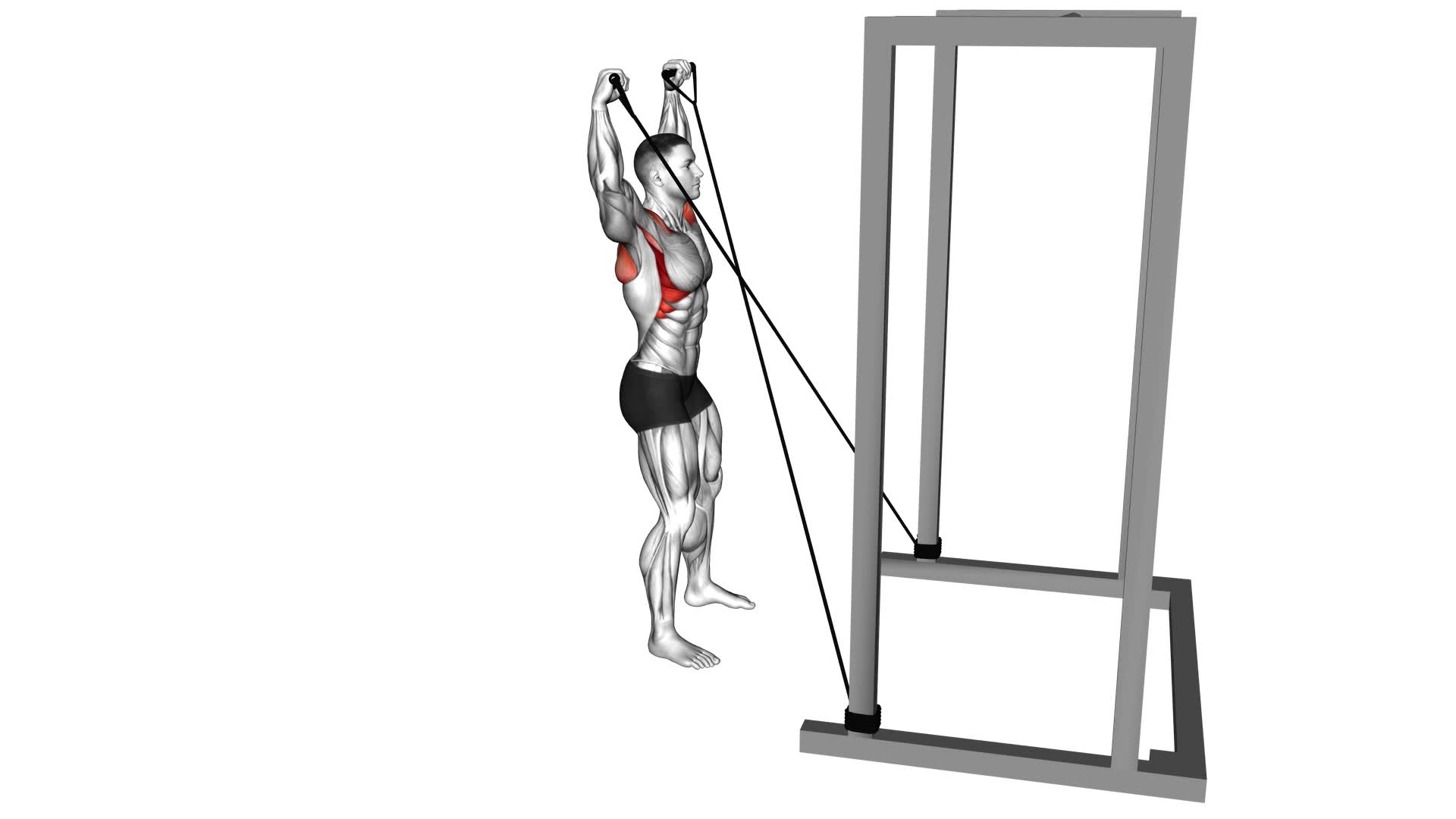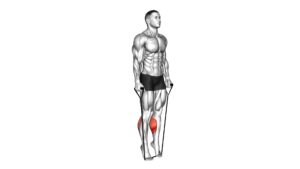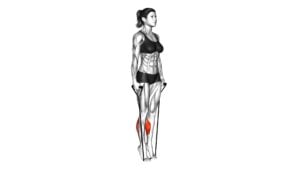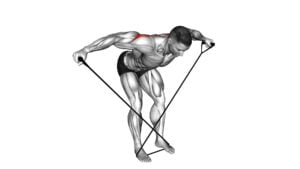Band Y Raise – Video Exercise Guide & Tips

Are you looking to tone and strengthen your upper body? Look no further than the Band Y Raise.
Watch This Exercise Video
This exercise targets your shoulders, upper back, and arms, helping you achieve a more defined physique.
In this video exercise guide, we'll show you the proper form and technique, as well as tips for choosing the right resistance band.
Avoid common mistakes, explore variations, and maximize your results with these helpful tips.
Let's get started!
Key Takeaways
- Band Y Raise targets shoulders, upper back, and arms for a more defined physique.
- Proper form and technique enhance stability, prevent strain on joints, and improve posture.
- Common form mistakes to avoid include rounding shoulders, using momentum instead of muscle strength, and not maintaining proper alignment.
- Choosing the right resistance band based on fitness level, exercise type, and desired versatility is important for maximizing benefits.
Benefits of Band Y Raise
Experience three key benefits of Band Y Raise to strengthen your upper body.
The Band Y Raise exercise offers numerous benefits that can help you improve your upper body strength and overall fitness. First, this exercise targets your shoulders, specifically the muscles in your upper back and deltoids. By regularly performing Band Y Raises, you can strengthen these muscles, which can lead to improved posture and reduced risk of shoulder injuries.
Second, Band Y Raises also engage your core muscles, including your abs and lower back. This exercise requires you to maintain stability and control throughout the movement, which helps to strengthen and tone your core.
Lastly, Band Y Raises can increase your shoulder mobility and flexibility. The controlled motion of raising your arms in a Y shape can help to improve your range of motion and enhance your overall shoulder flexibility.
By incorporating Band Y Raises into your workout routine, you can experience these three key benefits and improve your upper body strength.
With the understanding of the benefits of the Band Y Raise, it's important to ensure proper form and technique.
Proper Form and Technique
Now let's talk about the importance of proper form and technique when performing the Band Y Raise exercise.
It's crucial to maintain proper alignment throughout the movement to target the intended muscles effectively.
Common form mistakes to avoid include hunching your shoulders, arching your back, or using momentum to lift the bands.
Importance of Alignment
To ensure proper form and technique while performing the Band Y Raise, it's essential to maintain correct alignment throughout the exercise. Proper alignment not only helps you get the most out of the exercise but also reduces the risk of injury. Here are five reasons why alignment is crucial:
- Maximizes muscle engagement: Proper alignment ensures that the targeted muscles are activated effectively, leading to greater strength and muscle development.
- Enhances stability: Correct alignment promotes stability, allowing you to maintain balance and control during the exercise.
- Prevents strain on joints: Proper form reduces the stress placed on joints, minimizing the risk of joint pain or injury.
- Improves posture: By maintaining correct alignment, you can improve your overall posture and alignment throughout the day.
- Promotes optimal movement patterns: Maintaining proper form during the Band Y Raise helps you develop efficient movement patterns, improving your overall athletic performance.
Common Form Mistakes
Maintain proper form and technique during the Band Y Raise to avoid common form mistakes and optimize your results. By focusing on maintaining correct alignment and engaging the appropriate muscles, you can prevent injuries and improve your posture.
One common mistake to avoid is rounding your shoulders or hunching forward, as this can strain your neck and upper back. Instead, keep your chest lifted and your shoulder blades pulled back and down.
Another mistake is using momentum to swing your arms up, rather than relying on the strength of your muscles. To prevent this, move slowly and deliberately, focusing on squeezing your shoulder blades together at the top of the movement.
By maintaining proper form, you can maximize the benefits of the Band Y Raise and prevent unnecessary strain on your body.
Now, let's move on to the next section and discuss how to choose the right resistance band.
Choosing the Right Resistance Band
Start by finding the resistance band that works best for you. Here are some key factors to consider when choosing the right resistance band for your workout:
- Resistance Level: Different resistance bands offer varying levels of tension. Consider your fitness level and the specific exercises you plan to perform. A band with higher resistance will provide a more challenging workout.
- Material: Resistance bands are typically made from latex, fabric, or rubber. Latex bands are durable and stretchy, while fabric bands are softer and less likely to roll or slip. Rubber bands are lightweight and portable.
- Length: Resistance bands come in various lengths, typically ranging from 48 to 60 inches. Longer bands allow for more versatility in exercises and can accommodate different body sizes and movements.
- Handles: Some resistance bands come with handles attached, offering a comfortable grip and added stability during exercises. Handles can be particularly useful for exercises that require a firm grip, such as bicep curls or tricep extensions.
- Ankle Straps: If you plan to use resistance bands for lower body exercises, consider bands with ankle straps. These straps allow you to secure the band around your ankles, providing stability and targeting specific muscles in your legs and glutes.
Choosing the right resistance band is crucial for a safe and effective resistance band workout. Take the time to consider these factors and find the band that suits your needs and goals.
Common Mistakes to Avoid
To get the most out of your Band Y Raises, it's important to focus on proper form. This means maintaining a stable and controlled movement throughout the exercise, avoiding any jerky or hasty motions.
Overexertion can put unnecessary strain on your muscles and joints, so be sure to listen to your body and stop if you feel any pain or discomfort.
Lastly, incorporating injury prevention techniques such as warming up before your workout and using the appropriate resistance level can help keep you safe and injury-free.
Proper Form Importance
To ensure proper form and avoid common mistakes, it's important that you focus on the key points of the Band Y Raise exercise.
- Importance of Muscle Activation: Proper form ensures that you're activating the targeted muscles effectively, maximizing the benefits of resistance training.
- Benefits of Resistance Training: By maintaining proper form, you can enhance muscle strength, improve posture, and increase stability.
- Maintain a Neutral Spine: Avoid arching or rounding your back during the exercise to prevent strain on your spine.
- Engage Your Core: Activate your core muscles by drawing your belly button towards your spine, helping to stabilize your body throughout the movement.
- Controlled Movement: Move slowly and deliberately, focusing on the contraction of your shoulder blades, to ensure that you're engaging the correct muscles.
By following these tips, you can perform the Band Y Raise exercise with proper form and minimize the risk of injury.
Now, let's discuss how you can avoid overexertion risks.
Avoiding Overexertion Risks
To prevent overexertion and ensure a safe and effective Band Y Raise workout, it is important to focus on maintaining proper form and avoiding common mistakes. Overexertion can lead to injuries and hinder your progress in achieving effective workouts.
One common mistake to avoid is using too much resistance or tension in the band. It is recommended to start with a lighter band and gradually increase the resistance as you build strength.
Another mistake to avoid is using momentum instead of controlled movements. It is crucial to engage your muscles and perform the exercise with slow and controlled motions.
It is also important to avoid lifting your shoulders or arching your back during the exercise, as this can strain your neck and back.
Injury Prevention Techniques
To prevent injuries and maximize the effectiveness of your Band Y Raise workout, it's crucial to avoid common mistakes and practice injury prevention techniques. Here are some key tips to keep in mind:
- Perform warm-up exercises: Prior to starting your Band Y Raise workout, make sure to properly warm up your muscles. This will help increase blood flow and flexibility, reducing the risk of injury.
- Maintain proper form: Focus on maintaining proper posture and technique throughout the exercise. Avoid using momentum or swinging your arms, as this can strain your muscles and joints.
- Gradually increase intensity: Start with lighter resistance bands and gradually increase the intensity as your strength improves. Jumping into high resistance too quickly can lead to overexertion and injury.
- Listen to your body: Pay attention to any discomfort or pain during the exercise. If something doesn't feel right, stop and assess the situation to prevent further injury.
- Rest and recover: Give your body enough time to rest and recover between workouts. This will allow your muscles to repair and prevent overuse injuries.
Variations and Modifications
There are several ways you can modify the Band Y Raise exercise to suit your needs and abilities. If you want to adjust the intensity of the exercise, you can try using a lighter resistance band or decreasing the range of motion. By using a lighter band, you can reduce the resistance and make the exercise easier. Similarly, decreasing the range of motion can also make the exercise less challenging. For example, instead of raising your arms all the way up to shoulder level, you can start by raising them halfway and gradually increase the range as you get stronger.
If you're looking for advanced variations of the Band Y Raise, you can try incorporating other equipment such as dumbbells or kettlebells. Holding a dumbbell in each hand while performing the exercise can add more resistance and make it more challenging. You can also try performing the exercise on an unstable surface, such as a balance board or a stability ball, to engage your core and improve your balance.
Tips for Maximizing Results
Maximize your results by focusing on consistency and progression in your Band Y Raise workouts. To ensure you're getting the most out of your exercise routine and maximizing gains, here are some effective workout strategies to follow:
- Set specific goals: Clearly define what you want to achieve with your Band Y Raise workouts. Whether it's increasing strength, improving posture, or toning your upper body, having specific goals will help you stay motivated and track your progress.
- Maintain proper form: Proper form is crucial for maximizing the effectiveness of your Band Y Raise exercises. Pay attention to the alignment of your body and focus on engaging the targeted muscles throughout the movement. This will ensure you're getting the most out of each repetition.
- Progress gradually: As you become more comfortable with the Band Y Raise exercises, gradually increase the resistance or difficulty level. This progressive overload will challenge your muscles and promote continuous improvements.
- Rest and recover: Allow your body sufficient time to rest and recover between Band Y Raise workouts. This will prevent overtraining and reduce the risk of injury, allowing your muscles to repair and grow stronger.
- Stay consistent: Consistency is key in any fitness routine. Aim to incorporate Band Y Raise workouts into your weekly schedule and stick to it. Consistent and regular exercise will yield better results over time.
Frequently Asked Questions
How Long Should I Perform Band Y Raises in Each Workout Session?
To maximize the benefits of band Y raises and ensure proper form, it's recommended to perform them for about 10-15 repetitions in each workout session. This will help target your shoulder and upper back muscles effectively.
However, it's important to listen to your body and start with a weight and duration that feels comfortable for you. Gradually increase the intensity as you build strength and endurance.
Can Band Y Raises Help Improve Posture and Reduce Back Pain?
Band Y raises can indeed help improve posture and reduce back pain. By strengthening the muscles in your shoulders, these exercises promote proper alignment and support for your spine. To maximize the benefits, make sure to maintain proper form and technique.
Keep your core engaged, shoulders relaxed, and elbows slightly bent. Lift your arms up and out to form a Y shape, squeezing your shoulder blades together at the top.
Perform these exercises consistently to see improvements in your posture and reduction in back pain.
Is It Necessary to Warm up Before Performing Band Y Raises?
Before performing band Y raises, it's necessary to warm up. Warming up is important to prepare your muscles and prevent injuries.
Incorporating band Y raises into your workout routine can have numerous benefits, such as improving posture and reducing back pain. To properly perform band Y raises, start with a light resistance band and keep your core engaged.
There are variations of band Y raises that target different muscles. Avoid common mistakes like using too much momentum or shrugging your shoulders.
Can I Incorporate Band Y Raises Into My Existing Workout Routine?
Yes, you can definitely incorporate band Y raises into your existing workout routine. Adding resistance bands to your workouts has numerous benefits, such as increasing muscle strength and endurance.
Band exercises provide different variations for upper body strength, including targeting the shoulders, back, and arms. By incorporating band Y raises, you can specifically work on strengthening your shoulder muscles and improving your posture.
It's a great way to add variety and challenge to your routine.
Are There Any Specific Muscles That Band Y Raises Target?
Band Y raises target several specific muscles in your upper body. They primarily work your shoulders, specifically the deltoid muscles. These raises engage both the front and side deltoids, helping to strengthen and tone these areas.
Incorporating resistance bands into your workout routine, as opposed to using dumbbells, offers unique benefits. Resistance bands provide constant tension throughout the exercise, helping to improve muscle endurance and stability. Plus, they allow for a wider range of motion, targeting muscles from different angles.
Conclusion
In conclusion, incorporating band Y raises into your exercise routine can offer numerous benefits for your upper body strength and posture.
By following proper form and technique, using the appropriate resistance band, and avoiding common mistakes, you can maximize the effectiveness of this exercise.
Additionally, exploring variations and modifications can help target different muscle groups and prevent plateaus.
Remember to stay consistent and gradually increase resistance for optimal results.

Author
Years ago, the spark of my life’s passion ignited in my mind the moment I stepped into the local gym for the first time. The inaugural bead of perspiration, the initial endeavor, the very first surge of endorphins, and a sense of pride that washed over me post-workout marked the beginning of my deep-seated interest in strength sports, fitness, and sports nutrition. This very curiosity blossomed rapidly into a profound fascination, propelling me to earn a Master’s degree in Physical Education from the Academy of Physical Education in Krakow, followed by a Sports Manager diploma from the Jagiellonian University. My journey of growth led me to gain more specialized qualifications, such as being a certified personal trainer with a focus on sports dietetics, a lifeguard, and an instructor for wellness and corrective gymnastics. Theoretical knowledge paired seamlessly with practical experience, reinforcing my belief that the transformation of individuals under my guidance was also a reflection of my personal growth. This belief holds true even today. Each day, I strive to push the boundaries and explore new realms. These realms gently elevate me to greater heights. The unique combination of passion for my field and the continuous quest for growth fuels my drive to break new ground.



